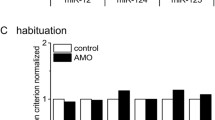Abstract.
The molecular mechanisms underlying the induction and maintenance of memory are highly dynamic and comprise distinct phases covering a time window from seconds to even a lifetime. Neuronal networks, which contribute to these processes, have been extensively characterized on various levels of analysis, and imaging techniques allow monitoring of both gross brain activity as well as functional changes in defined brain areas during the time course of memory formation. New techniques developed in honeybees and fruit flies even allow for manipulation of neuronal networks and molecular cascades in a short temporal domain while a living animal under observation acquires new associative memories. These advantages make honeybees and flies ideal organisms to study transient molecular events underlying dynamic memory processing in vivo. In this review we will focus on the temporal features of molecular processes in learning and memory formation, summarize recent knowledge and present an outlook on future developments.
Similar content being viewed by others
Author information
Authors and Affiliations
Corresponding author
Rights and permissions
About this article
Cite this article
Schwärzel, M., Müller, U. Memory. Cell. Mol. Life Sci. 63, 989–998 (2006). https://doi.org/10.1007/s00018-006-6024-8
Published:
Issue Date:
DOI: https://doi.org/10.1007/s00018-006-6024-8




